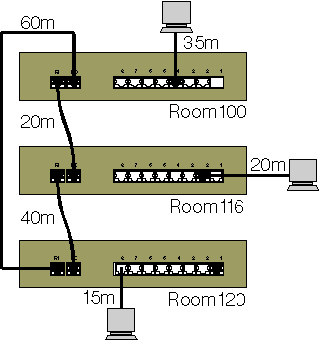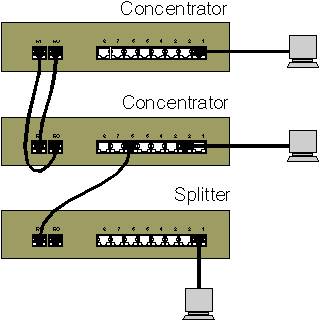
Product Description The 8226 is a low-cost, passive token ring access unit that provides RJ45 connection for attaching workstations and other token ring devices to a 4 or 16 Mbps token ring network using Category 4 or 5 (unshielded twisted pair) UTP cabling. Features
LED Explanation:
As your growing business requires continued growth of your network,
the 8226 can be used with a hub or concentrator to serve additional workstations
without changing your building cabling.
The stand-alone ring The IBM 8226 can be used as a stand-alone ring, by
attaching up to eight workstations or devices to the 8226's RJ-45 ports
8226 Ring Limits 
IBM 8226s can also be used together by cabling up to ten
8226s via their Ring-In/Ring-Out (RI/RO) ports and then attaching up to
eight workstations to each 8226's RJ-45 ports
Concentrator/Splitter Allows to use the 8226 as a splitter when attached mode switch to another 8226 or as a concentrator. Instead of using a separate hub or concentrator port for each device you want to connect, you can attach the 8226 to an existing hub or concentrator port, set the switch on the front of the 8226 to "Splitter," and connect up to eight additional devices to the 8226
Some words about Cable length
(sum of MPR cables - shortest MPR cable) + LLL should be <= 145m (478 feet) for 4 Mbps - or -should be <= 290 meter (957 feet) for 16 Mbps MPR = Main Ring Path LLL = Longest Lobe Length If the ring has e.g. three 8226s connected with cables of 40 m (132 ft), 60 m, (165 ft) and 80 m (264 ft) with a longest lobe length of 50 m (165 ft), distance of 95 m (313 ft), it falls within the guidlines. However, if these distances where all doubled, the transmission distance would be 190 m (627 ft), clearly in violation of the maximum distance guidlines. |

